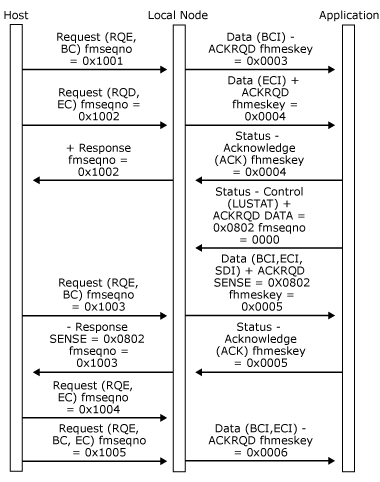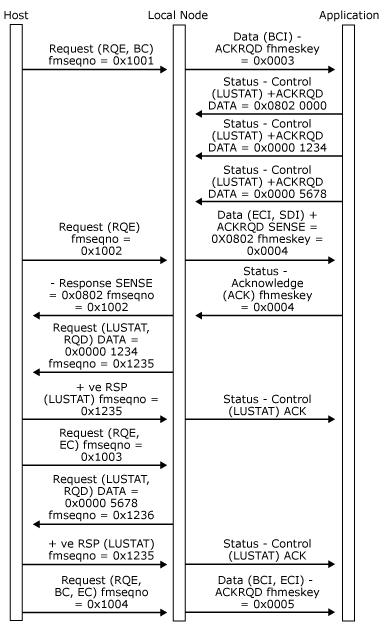LUSTATs]
The data flow control (DFC) logical unit status LUSTAT message is used within SNA to convey four bytes of sense data to the other session partner. It can also be used simply to send a response header (RH) to the other session partner (for example, to open a bracket). (For more information, see the figures in Bracket Initiation.) The message flows on the normal flow and so is subject to direction restrictions. However, it can be sent without end bracket (EB) or change direction (CD) on a half-duplex flip-flop session that is in error recovery pending state. (For more information, see Recovery.)
The local node allows the application to send Status-Control(LUSTAT) Request messages at any time that data traffic is active, except while sending data in chain. If the application is in a receiving state (using half-duplex protocol), the LUSTAT is queued up and used to provide the sense codes, which are filled into the next outbound request, and the SDI flag is set. The application can therefore present the sense codes for an error state without waiting for the next outbound data if required.
The first byte of sense data must be 0x08 to generate a DATAFMI message with SDI (to be converted to a negative response). Other LUSTATs are left queued on the session until they can be sent.
If multiple Status-Control(LUSTAT) messages are sent by the application while in a receive state, the local node queues them all. When outbound data has been delivered to the application with SDI set, as indicated earlier, and the application has converted it to a Status-Acknowledge(Ack), the local node sends the negative response and the remaining LUSTATs (which can now flow because the half-duplex flip-flop state is error recovery pending).
If the application intends to send multiple Status-Control(LUSTAT) messages to the host, it is possible that the host will attempt to initiate recovery before the last LUSTAT has been sent. In this case, the error recovery chain will be rejected by the next LUSTAT.
Note that the application can send Status-Control(LUSTAT) Request with or without ACKRQD. The local node will map these to RQD and RQE LUSTATs respectively.
The following three figures illustrate the use of Status-Control(LUSTAT) messages by an application using the half-duplex flip-flop mode.
In the first figure, the application issues Status-Control(LUSTAT) when it has direction.

Application issues Status-Control(LUSTAT) when it has direction
In the following figure, the application sends Status-Control(LUSTAT) request when receiving data between chain. Next, outbound data is delivered with SDI set, which gets converted to negative RSP.

Application issues Status-Control(LUSTAT) request when receiving data between chain
In the following figure, the application sends several Status-Control(LUSTAT) requests when receiving data in chain. Next, outbound data is delivered with SDI set which gets converted to negative response. Subsequent LUSTATs are sent to host.

Application sends several Status-Control(LUSTAT) requests when receiving data in chain
See Also
Opening the PLU Connection
Closing the PLU Connection
PLU Session
Outbound Chaining
Inbound Chaining
Segment Delivery
Brackets
Direction
Pacing and Chunking
Confirmation and Rejection of Data]
Shutdown and Quiesce
Recovery
Application-Initiated Termination
Response Time Monitor Data